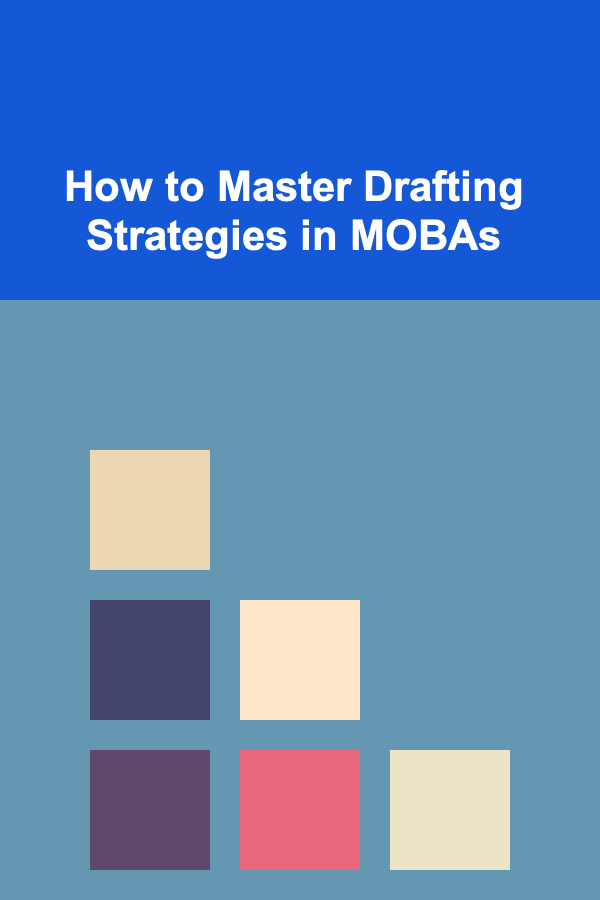
How to Master Drafting Strategies in MOBAs
ebook include PDF & Audio bundle (Micro Guide)
$12.99$8.99
Limited Time Offer! Order within the next:

Mastering the art of drafting in Multiplayer Online Battle Arenas (MOBAs) is one of the most critical aspects of competitive gaming. While individual skill and teamwork remain essential, the draft phase sets the stage for the match, and it can often determine the outcome long before the first blood is spilled. In this article, we will dive into the intricacies of drafting strategies in MOBAs, focusing on key principles, strategies, and techniques that can help players master the draft phase.
The Importance of the Draft Phase
In most MOBAs, the draft phase occurs at the beginning of the match and serves as a crucial point where teams select their heroes or champions. Unlike the gameplay phase, where execution is key, the draft phase is about strategic decision-making. Here, teams must consider several factors, including hero synergies, counter-picks, team composition, and bans. The goal is to create a team composition that has a higher chance of winning based on the specific strengths and weaknesses of both teams.
In MOBAs like League of Legends , Dota 2 , and Smite, drafting is more than just picking powerful champions; it involves understanding the meta, predicting your opponent's picks, and adapting to potential counters. Understanding these dynamics and how they influence the game can make a significant difference in competitive play.
The Meta: Why It Matters
Before we dive deeper into drafting strategies, it's essential to understand what "the meta" means in the context of MOBAs. The term "meta" refers to the prevailing trends and strategies that dominate the current competitive landscape. These trends evolve over time as game developers balance the game by buffing and nerfing champions, heroes, or items. Staying updated on the meta allows you to draft picks that are considered strong, as well as avoid picks that have fallen out of favor due to changes in balance.
The meta can be highly dynamic, shifting with every patch. As such, mastering the meta involves not only understanding the champions or heroes that are strong but also recognizing the strategies that dominate the current competitive play. For example, in League of Legends , a meta focused on tank-heavy compositions may emphasize picks like Ornn and Sion, whereas in Dota 2, a meta that favors high-damage carries like Terrorblade may shift the draft toward heroes with strong scaling abilities.
To truly master drafting, players must have a deep understanding of the meta at any given time and be able to adjust their strategies based on those trends.
Key Drafting Concepts and Principles
1. Team Composition
A well-balanced team composition is critical to success. While each hero has unique abilities, it is essential to think of the overall team synergy when selecting your picks. A successful team composition should generally have a mix of the following:
- Frontline/Tank: These champions or heroes absorb damage, allowing the squishy backline carries to deal damage safely. Tanks are usually initiators who engage in fights and create space for the team.
- Damage Dealers: These heroes provide the bulk of the damage output in fights. Depending on the composition, damage dealers may be physical, magical, or a mix of both. Carry champions generally require resources to scale, so picking one who can reliably farm and deal significant damage is essential.
- Supports: Support heroes provide utility and healing. They keep the team alive and may also provide crowd control or other forms of assistance, like vision control or buffs.
- Crowd Control (CC): Some heroes specialize in crowd control, which is essential in disrupting enemy teams. Stuns, silences, slows, and roots are all forms of crowd control that can turn the tide of a battle.
The key here is to strike a balance. Overloading your team with damage dealers or crowd control can make you too predictable and prone to being outmaneuvered by a more well-rounded composition.
2. Flex Picks
Flex picks are champions or heroes that can fill multiple roles in the draft phase. These picks are highly valuable because they provide your team with greater strategic flexibility and can confuse or disrupt your opponent's picks. For example, in League of Legends, champions like Gragas and Karma can be played in multiple positions, such as support, jungle, or even mid lane. Picking flex champions forces your opponent to guess where you might place those heroes, making it harder for them to create a counter-strategy.
Flex picks also allow your team to adapt based on what your opponents select. If your team has a champion that can play in multiple roles, you might delay the final selection of your lineup to see what your opponents pick, allowing you to make a more informed decision.
3. Counter-Picking
Counter-picking is one of the most potent aspects of drafting in MOBAs. It involves selecting heroes that exploit the weaknesses of your opponent's picks. For example, in Dota 2 , heroes with burst damage or lockdown abilities are great counters to high-impact carries like Anti-Mage, who rely on mobility. Similarly, in League of Legends, selecting champions with strong poke or range can negate the impact of melee-heavy compositions.
To counter-pick effectively, you need to have a good understanding of each hero's strengths, weaknesses, and common counters. This requires knowledge of both the meta and the specific abilities of each hero. Being able to predict and exploit enemy picks during the draft is a skill that can be honed with experience and study.
4. Bans
Banning heroes during the draft phase is a critical strategy that can make or break your team's success. Bans allow you to remove potentially game-changing champions or heroes from the pool, reducing the options available to your opponents. Effective bans are often based on two factors:
- Meta Picks: Banning overpowered heroes that are strong in the current meta is an essential part of drafting. If your opponent is known to have a player who excels with a particular hero, it may be wise to remove that hero from their options.
- Countering Opponent Strategy: In some cases, banning heroes that complement your opponent's strategy is crucial. For example, if the enemy team is drafting a heavy melee composition, banning heroes with strong poke or AoE (Area of Effect) damage can limit their effectiveness.
It is also useful to consider the banning phase as part of your overall strategy. Instead of blindly banning the most powerful heroes in the meta, you should try to predict your opponent's desired picks and deny them options that would complement their draft.
5. Adaptation and Reaction
A good drafter is always adaptable. Just because you have a specific strategy in mind doesn't mean you should stick with it regardless of your opponent's picks. Flexibility is critical in the draft phase because things can change quickly based on the picks and bans of both teams.
- Reacting to the Opponent's Draft: Pay attention to how your opponents pick and adjust accordingly. If they select several high-mobility heroes, consider adding more crowd control to your team. If they pick squishy champions, it may be wise to opt for high-burst damage heroes or assassins.
- Counteracting Strategy Shifts: Sometimes, the best counter-strategy is one that surprises the enemy team. If they are drafting around a certain meta trend, consider going for an unconventional pick that breaks their plan.
Advanced Drafting Techniques
While the principles above are fundamental to drafting, there are a few advanced techniques that can set you apart as a master drafter.
1. Psychological Warfare
The draft phase is not only about mechanics but also about playing mind games with your opponents. Psychological warfare in drafting involves bluffing, misdirection, and manipulation of your opponent's expectations.
For example, you might intentionally pick a hero that signals a particular strategy, only to swap it out for a different pick once your opponent has committed to their counter-strategy. By making your opponents second-guess their picks, you can force them into uncomfortable positions.
2. Predicting the Meta
Meta prediction is a skill that involves anticipating which heroes or strategies will rise to prominence in the future. Mastering the ability to predict the direction of the meta before it becomes mainstream can give you a significant advantage over less-informed teams. This requires staying updated on patch notes, analyzing professional games, and having a deep understanding of hero dynamics.
3. Team Coordination
Effective drafting isn't just about individual skill---it's about coordination within your team. A good drafting strategy involves everyone on the team contributing their knowledge and ideas. Team captains or lead drafters should consider the strengths and weaknesses of each player and ensure that the team's overall strategy is cohesive. Open communication between players is essential, especially when dealing with flex picks, counter-picks, and bans.
Conclusion
Mastering drafting strategies in MOBAs is a complex and dynamic process that requires deep knowledge of the game's heroes, the current meta, and the strategies that dominate competitive play. It's about balancing team composition, counter-picking effectively, and predicting your opponent's decisions. Drafting is an art form that takes practice, patience, and a lot of experience to truly master.
By focusing on key principles like team composition, counter-picking, bans, and flexibility, players can significantly improve their chances of success. As you grow as a player, you'll develop a more intuitive understanding of the draft phase and be able to make smarter, more effective decisions. Whether you are playing League of Legends , Dota 2 , Smite, or any other MOBA, mastering the draft phase is essential for competitive success.

How to Clean and Maintain Your Home's Baseboards and Trim
Read More
How to Create a Command Center for Family Organization
Read More
How to Keep Your Home Dust-Free in High-Allergy Seasons
Read More
How to Light Your Home Safely and Efficiently
Read More
How to Sell Used Designer Handbags on Poshmark: An Actionable Guide
Read More
The Definitive Guide to Propagating Plants from Cuttings
Read MoreOther Products

How to Clean and Maintain Your Home's Baseboards and Trim
Read More
How to Create a Command Center for Family Organization
Read More
How to Keep Your Home Dust-Free in High-Allergy Seasons
Read More
How to Light Your Home Safely and Efficiently
Read More
How to Sell Used Designer Handbags on Poshmark: An Actionable Guide
Read More